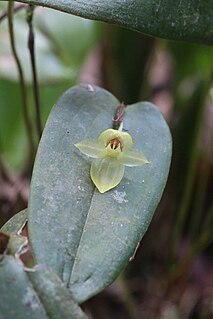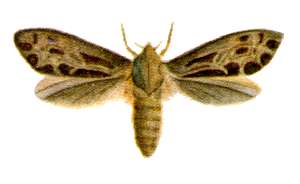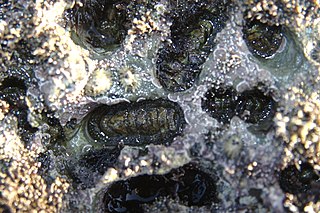| Crossota rufobrunnea | |
|---|---|
| Scientific classification | |
| Kingdom: | Animalia |
| Phylum: | Cnidaria |
| Class: | Hydrozoa |
| Order: | Trachymedusae |
| Family: | Rhopalonematidae |
| Genus: | Crossota |
| Species: | C. rufobrunnea |
| Binomial name | |
| Crossota rufobrunnea (Kramp, 1913) | |
| Crossota rufobrunnea | |
|---|---|
| Scientific classification | |
| Kingdom: | Animalia |
| Phylum: | Cnidaria |
| Class: | Hydrozoa |
| Order: | Trachymedusae |
| Family: | Rhopalonematidae |
| Genus: | Crossota |
| Species: | C. rufobrunnea |
| Binomial name | |
| Crossota rufobrunnea (Kramp, 1913) | |

Pleurothallis is a genus of orchids commonly called bonnet orchids. The genus name is derived from the Greek word pleurothallos, meaning "riblike branches". This refers to the rib-like stems of many species. The genus is often abbreviated as "Pths" in horticultural trade.

Morchella, the true morels, is a genus of edible sac fungi closely related to anatomically simpler cup fungi in the order Pezizales. These distinctive fungi have a honeycomb appearance due to the network of ridges with pits composing their caps. Morels are prized by gourmet cooks, particularly in French cuisine. Due to difficulties in cultivation, commercial harvesting of wild morels has become a multimillion-dollar industry in the temperate Northern Hemisphere, in particular North America, Turkey, China, the Himalayas, India, and Pakistan and Kashmir where these highly prized fungi are found in abundance.

Oncopera is a genus of moths of the family Hepialidae. There are 12 described species, all endemic to Australia. The larvae usually feed on grasses, although that of O. intricata has been recorded on strawberry.

The Príncipe seedeater is a species of finch in the family Fringillidae. It is found only on the islands of São Tomé and Príncipe off the west coast of Africa. Its natural habitats are subtropical or tropical dry forest and subtropical or tropical moist lowland forest.
Crossota millsae is a species of deep-sea hydrozoan. These small ocean-dwelling creatures are bioluminescent; the light emitted by these jellyfish serves as a defense or warning to other creatures. Males and females have both been described, and it reproduces sexually. They are viviparous and females brood baby medusae attached to the gastric canals inside the sub-umbrellar space.

Crossota is a genus of hydrozoans of the family Rhopalonematidae. The genus comprises five species. Unlike most hydromedusae, these do not have a sessile stage. Rather, they spend their entire lives in the water column as plankton. The genus Crossota is widespread throughout the oceans.

Crossota norvegica is a species of hydrozoan in the family Rhopalonematidae. It is closely related to Crossota millsae and is found in the Arctic Ocean at depths below 1,000 m (3,300 ft). Crossota norvegica is also known as the deep red jellyfish. This species is described as “alien-like” and is known for its vibrant red hue. It is a small cnidarian, reaching only up to 2 cm in its body size.

Rhopalonematidae is a family of hydrozoans. The family comprises 15 genera and 36 species.

Morchella elata is a species of fungus in the family Morchellaceae. It is one of many related species commonly known as black morels, and until 2012 the name M. elata was broadly applied to black morels throughout the globe. Like most members of the genus, M. elata is a popular edible fungus and is sought by many mushroom hunters.

Vampyrocrossota is a genus of hydrozoans of the family Rhopalonematidae. The genus only contains one species, Vampyrocrossota childressi. Unlike many hydromedusae, these animals do not have a sessile stage. Rather, they spend their entire lives in the water column as plankton. It is the only known species with a medusa that is truly black.

Morchella tomentosa, commonly called the gray, fuzzy foot, or black foot morel, is a species of fungus in the family Morchellaceae. M. tomentosa is a fire-associated species described from western North America, formally described as new to science in 2008.

Morchella rufobrunnea, commonly known as the blushing morel, is a species of ascomycete fungus in the family Morchellaceae. A choice edible species, the fungus was described as new to science in 1998 by mycologists Gastón Guzmán and Fidel Tapia from collections made in Veracruz, Mexico. Its distribution was later revealed to be far more widespread after several DNA studies suggested that it is also present in the West Coast of the United States, Israel, Australia, Cyprus, Malta and Switzerland.
Thysanocrepis crossota is a moth of the family Tortricidae. It is found in Thailand, the Solomon Islands, New Guinea and Vietnam. Records for Australia represent a misidentification.
Mordellistena rufobrunnea is a species of beetle in the genus Mordellistena of the family Mordellidae. It was described by Champion in 1927.

Morchella anatolica is a rare species of ascomycete fungus in the family Morchellaceae. It was described as new to science in 2010 from southwest Anatolia, Turkey, where it grows on moss-covered stream beds in pine forests. An ancient climatic relict, M. anatolica is restricted to the Mediterranean basin and has also been documented in Spain, Cyprus and Greece, where it is sometimes encountered with trees of the Oleaceae family. Together with its sister-species Morchella rufobrunnea, they are the earliest diverging lineages in genus Morchella, forming a distinct clade that is basal in global morel phylogenies. Because of its phylogenetic position, M. anatolica has been crucial in inferring the historical biogeography of the genus, which is estimated to have emerged somewhere in the Mediterranean region in the late Jurassic.
Eburia rufobrunnea is a species of beetle in the family Cerambycidae.
Apterapomecyna rufobrunnea is a species of beetle in the family Cerambycidae, and the only species in the genus Apterapomecyna. It was described by Breuning in 1970.
Pterolophia rufobrunnea is a species of beetle in the family Cerambycidae. It was described by Stephan von Breuning in 1938.
Crossota alba is a species of hydrozoan in the family Rhopalonematidae. this species does not have sessile stage as other hydromedusae. Crossota is spread all over the ocean and lives their life in water as plankton. Crossota alba are commonly distributed in the west coast waters of India.

Nuttallina is a genus of chitons belonging to the family Lepidochitonidae.